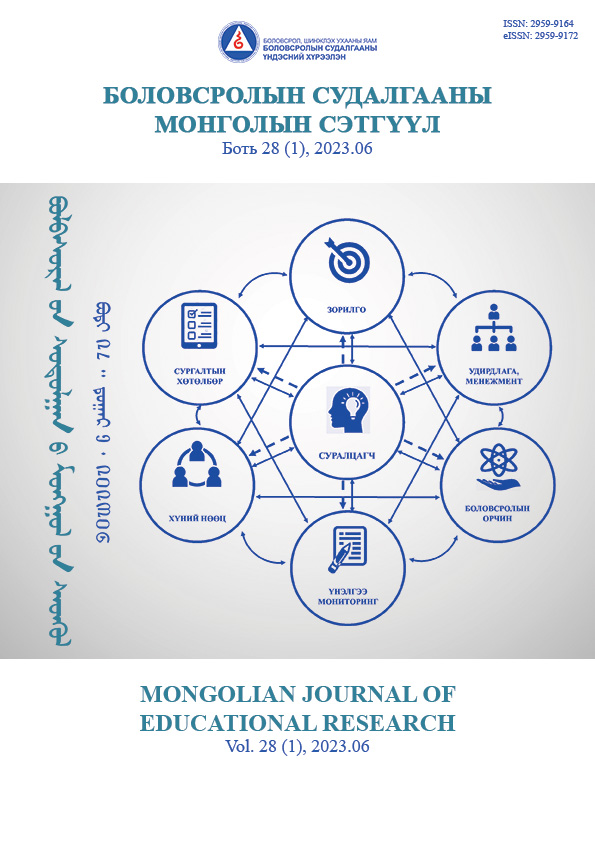A study results of investing social impacts on budgeting at secondary education level in
DOI:
https://doi.org/10.56380/mjer.v28.1.3Keywords:
funding for education, general education budget, funding social, economic effects, efficiency of the budgetAbstract
Nowadays, Mongolia has been considering to the improvement of new knowledge-based industries, contributing to development of the social, economic, and educational sectors, and developing government policies on education. In order to prepare Mongolian citizens, many quality reforms have been developed and implemented in coordination with the financing mechanism to meet the educational goals. In our country, it needs the long-term and sustainable policies and financial management are important for the comprehensive and effective implementation of the budget process, such as development, planning, operation and control of the budget for the education sector, to allow for many internal and external factors for instance, geographical features, demographic structure, problems facing the education system. Therefore, there is a need and requirement to support the provision of qualified human resources to local educational institutions by training specialized financial management and human resources (public financiers, economists, researchers) in the field of education to implement sustainable and long-term financial policies at the national and local levels. General education has financed from the state budget, and the normative cost benchmarking indicators are updated several times, so the availability of information is limited. We are based on detailed information from the National statistical commission, 1212.mn and the Ministry of Finance and Investment Department.
At this point, the education sector is including general education budget expenses and fundings which are measured by current state and local budget expenditure indicators, social effects are measured by some macroeconomic indicators, and their interrelationships are studied and evaluated based on the data and information of the last 11 years.
This article presents the results of a study that describes the relationship between the general education budget and some macro indicators of society and economy.
Downloads
References
Berne, R., Stiefel, L. (1994). Measuring equity at the school level: The Finance perspective. Educational Evaluation and Policy Analysis, 16-4, 405-421.
Blank, R. (2002). Evaluating Welfare Reform in the United State. Journal of Economic Literature, American Economic Association 40, p.1105-1166.
Doltan, P., Levacic, R., Vignoles, A. (2004). The economic impact of schooling resources, . Human capital over the life cycle, p.36-52.
Guthrie, J. (2006). Modern education finance. American Education Finance Association.
Hanushek, Rivkin, Taylor . (1996). Aggregation and the estimated effects of school resources. Review of Economics and Statistics, 78/4/11, p.611-627.
Odden, A. (2000). The new school finance: Providing adequacy and improving equity. Journal of Education Finance, 25/4, p.467-487.
OECD. (1998). Human Capital Investment: An International Comparison. Paris: OECD.
OECD. (2015). Compendium of Productivity Indicators
Preston, J and Green, A. (2003). The Macro-Social Benefits of Education, Training and Skills in Comparative Perspective. Centre for Reseach on the Wider Benefits of Learning. №9.
Scheerens, J. (2004). Review of school and instructional effectiveness research. Paris: UNESCO.
UNESCO . (2019). Global Education Monitoring Report 2019: Migration, displacement and education: BUILDING BRIDGES, NOT WALLS. Paris: UNESCO.
UNESCO. (2009). CONFINTEA-VI: Belem Framework for Action. Belem, Brazil: UNESCO.
UNESCO. (2009). Education Indicators Technical guidelines. UNESCO Institute for Statistics.
UNESCO. (2015). Rethinking Education. Towards a global common goods. UNESCO.
UNESCO. (2018). Quick Guide to Education Indicators for SDG 4. UNESCO, Institute for Statistics.
UNICEF. (2016). “Child-focused Public Expenditure Measurement: A Compendium of Country Initiatives”
UNICEF. (2017). “UNICEF’s Engagements in Influencing Domestic Public Finance for Children (PF4C) A Global Programme Framework”
Woodhall, M. (2004). Cost-benefit analysis in education planning. Spain: UNESCO.
АХБ. (2019). Боловсролын санхүүжилт, хөрөнгө оруулалтын тайлан.
Бандий, Р. (1995). "Боловсролын эдийн засаг" Боловсролын удирдлага онолын асуудал УБ 1995. тал 35-43
Бандий. Р (2002) "Боловсрол тэргүүлэх салбар болох ерөнхий шалгуур үзүүлэлтийг тодорхойлох нь" Монголын боловсрол судлаач эрдэмтдийн сонгомол өгүүллийн түүвэр - XX зуун. тал 77-83
Бандий.Р (2001). "Боловсролын зах зээлийн онцлог, түүний маркетингийг хөгжүүлэх асуудалд" XX зууны Монголын Боловсрол судлал тал 124-134
Батболд, Т. (2014). "Монгол Улс дахь боловсролын хөрөнгө оруулалтын өгөөжийн шинжилгээ" диссертац
Батцэцэг, С. (2022). “Ерөнхий боловсролын санхүүжилтийн үр ашгийг нэмэгдүүлэх зарим асуудал" диссертац
Бэгз, Н. (2011). "Глобальчлалын үеийн Монгол улсын боловсролын хөгжлийн онол, арга зүйн үндэс асуудлууд" диссертац
Бэгз. Н., Санжаабадам. С., нар. (2018). Хүүхэд залуучуудын хөгжлийн онол, аргазүй.
ДБ. (2009). “Төсвийн зардал, санхүүгийн удирдлагын тойм судалгаа”
ДБ. (2014). “Монгол улсын боловсролын салбарт үзүүлж буй гадаадын зээл, тусламжийн чиглэл, үр дүн нөлөөллийн судалгаа”

